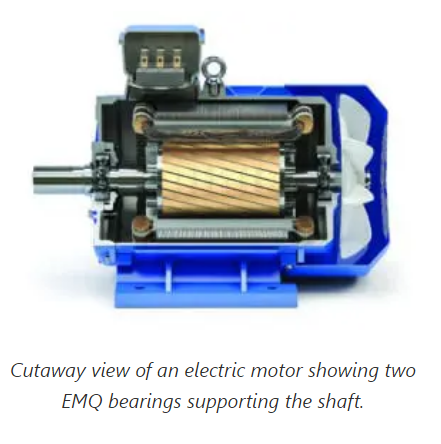Welcome to Sino Bearings web
24x7 HOTLINE:+86-28-81454188

 TECHNOLOGY
TECHNOLOGY
The demand for a quiet electric motor – meaning, one that runs with very little noise and vibration – was the primary application that drove engineers to develop and market low-noise ball bearings. Accordingly, the manufacturing equipment industry coined the term electric motor quality (EMQ) to identify this special class of low-noise bearings.
Today, a wide range of applications require the use of EMQ bearings.
Where the noise comes fromNoise in a rotating bearing is the audible component of vibration and a function of rotational speed. The greater the vibration, the shorter the bearing’s lifespan – plus, excessive vibration is capable of damaging the motor or machinery.
Vibration is caused by several factors, including rough or damaged raceway and ball surfaces, poor geometric tolerances (roundness, concentricity, runout, and/or parallelism), contamination, improper lubrication, incorrect radial play, and improper shaft and housing fits.
How we reduce the noiseAn EMQ bearing is manufactured by superfinishing the rolling contact surfaces to a mirror-like finish, which provides for very smooth rotation. Equally important is maintaining tight control of the geometric tolerances of the bearing components.
Particle contamination in a bearing adds to the noise level – engineers can prevent this, however, by using seals to prevent ingress of contaminants and taking care to use only “clean” lubricants that have been filtered to remove large solid particles. Specifying the proper radial clearance is also vital: it should be as close to zero as possible, without causing the bearing to bind up during rotation. If the radial clearance is too loose, it results in excessive noise-causing vibration.
As with any type of bearing, the lifespan of EMQ bearings also depends on external factors. Great care should be taken during handling and mounting because impact forces from dropping a bearing or hitting it during installation can create small dents in the raceways, called brinelling. Brinelling creates excessive vibration during rotation, eventually leading to bearing failure.
Shaft and housing roundness can also contribute to noise, especially in smaller and thin-section bearings. Poor roundness can distort the bearing rings upon installation, which prevents smooth rotation and leads to the generation of noise.
Manufacturers of EMQ bearings typically perform 100% noise inspection on the bearings using a special piece of equipment called the Anderon meter (or a similar instrument). This device measures the vibration velocity (displacement x frequency) of a rotating bearing in Anderon units (equivalent to 7.5 microns per second) across three frequency bands: low, medium, and high. The higher the vibration velocity, the noisier the bearing.
Lastly, it’s important to stress the fact that EMQ standards are not uniform between bearing manufacturers – except those located in China, where there is a national standard. Despite this lack of uniformity, however, you may rest assured that an EMQ rating from a manufacturer (based on sufficient empirical evidence) indicates the bearing is suitable for use in electric motors.